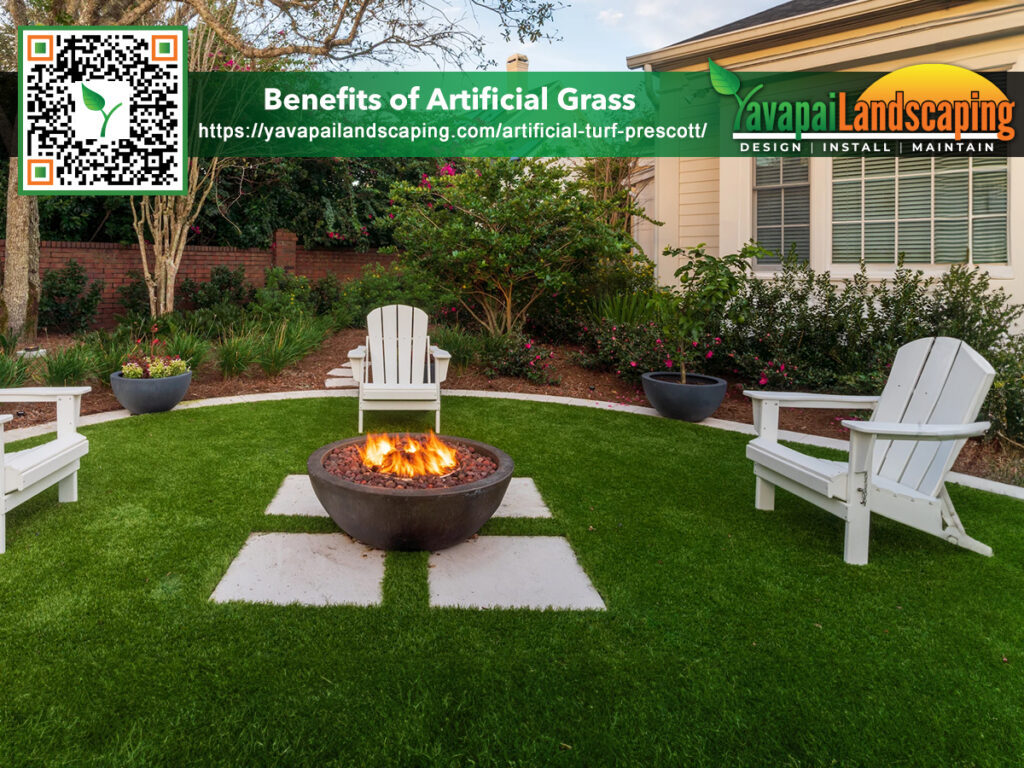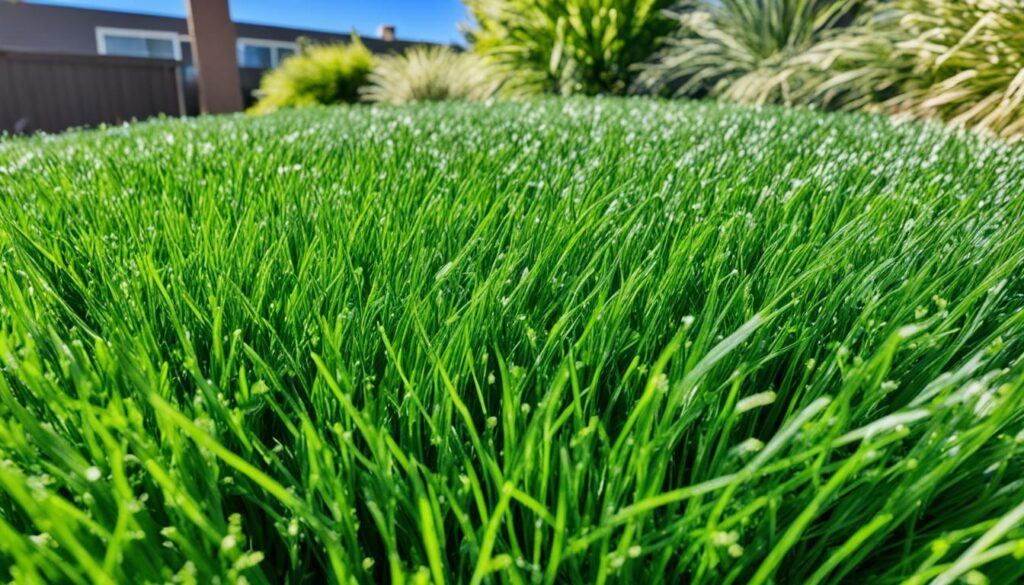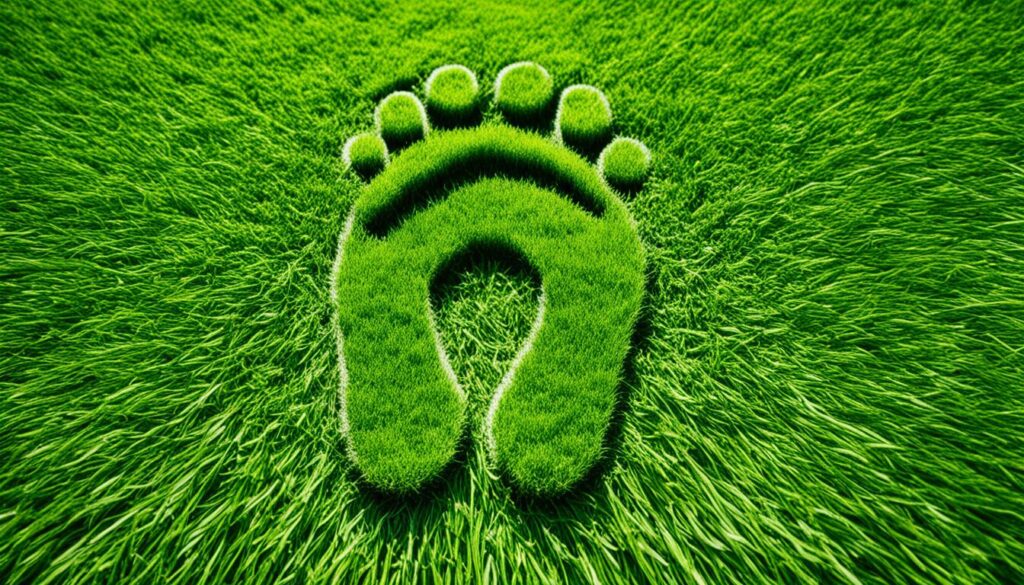
As more people embrace sustainable living and eco-friendly solutions, the use of artificial grass for landscaping purposes has gained significant popularity. With its numerous environmental benefits, artificial grass provides a sustainable alternative to traditional lawns. Let’s explore the various advantages of artificial grass and how it contributes to sustainable landscaping practices.
Key Takeaways:
- Artificial grass offers numerous environmental benefits for sustainable landscaping.
- By eliminating the need for regular watering, artificial grass helps conserve water.
- Artificial grass reduces reliance on chemical pesticides and fertilizers, promoting a healthier outdoor environment.
- With minimal maintenance requirements, artificial grass conserves energy and resources.
- The production and maintenance of artificial grass contribute to a lower carbon footprint compared to natural grass.
- Artificial grass provides longevity and durability, reducing waste generation and promoting a longer lifespan for outdoor spaces.
- In Prescott, AZ, artificial grass is an ideal choice for sustainable landscaping, considering the unique climate conditions of the region.
Water conservation benefits of artificial grass
When it comes to sustainable landscaping, water conservation is a key consideration. Artificial grass, also known as eco-friendly turf, offers significant water-saving benefits compared to natural grass. By eliminating the need for regular watering, artificial grass helps conserve water, a precious resource essential for our environment and communities.
One of the main advantages of artificial grass is its ability to reduce water consumption. Unlike natural grass, which requires frequent irrigation to maintain its lush appearance, eco-friendly turf retains its green and vibrant look without the need for regular watering. This not only saves water but also minimizes the strain on local water supplies, making it an eco-conscious choice for sustainable landscaping.
By opting for artificial grass, homeowners and businesses can take a proactive approach to water conservation. The water-saving benefits of eco-friendly turf extend beyond just reducing water bills; they contribute to the bigger picture of protecting our environment.
Specific Water Conservation Benefits:
- Eliminates the need for regular watering
- Reduces strain on local water supplies
- Conserves water, a vital and finite resource
Artificial grass offers a sustainable landscaping solution by minimizing water usage. Its low-maintenance nature means you no longer have to worry about watering schedules or wasting water on maintaining a lush lawn. This allows you to enjoy a green and vibrant outdoor space while playing your part in water conservation efforts.
| Comparison of Water Usage | Natural Grass | Artificial Grass |
|---|---|---|
| Water Requirement | High | None/Low |
| Water Conservation Benefits | Limited | Significant |
Reduced reliance on chemical pesticides and fertilizers
One of the key environmental benefits of artificial grass is its ability to reduce the reliance on chemical pesticides and fertilizers commonly used in maintaining natural grass. By eliminating the need for these harmful chemicals, artificial grass offers a more eco-friendly and sustainable landscaping solution.
Conventional grass maintenance often involves the use of pesticides and fertilizers to control pests and promote growth. However, these chemicals can have detrimental effects on the environment, contaminating soil, and water sources, and posing a risk to wildlife and human health.
With the use of artificial grass, the need for chemical treatments is significantly diminished. The synthetic fibers and infill materials used in artificial grass are specifically designed to resist pests and maintain their lush appearance without the need for additional chemical inputs.
By reducing the application of pesticides and fertilizers, artificial grass helps minimize pollution and its negative impacts on the environment. This promotes healthier and safer outdoor spaces for families, pets, and wildlife, while also contributing to a more sustainable approach to landscaping.
Not only does the reduced reliance on chemical treatments benefit the environment, but it also provides a time and cost-saving advantage for homeowners and businesses. Without the need for ongoing pesticide applications and fertilization, maintenance efforts are significantly reduced, leading to less time, money, and resources spent on lawn care.
If you’re looking for a greener alternative to traditional lawn maintenance, artificial grass offers an eco-friendly turf option that supports sustainable landscaping practices and promotes green living solutions.
Benefits of reduced reliance on chemical pesticides and fertilizers:
- Minimizes environmental pollution
- Promotes healthier and safer outdoor spaces
- Saves time, money, and resources on lawn care
- Supports sustainable landscaping practices

| Environmental Benefits of Artificial Grass | Sustainable Landscaping Solutions | Green Living Solutions |
|---|---|---|
| Reduces reliance on chemical pesticides and fertilizers | Conserves water through reduced irrigation needs | Reduces carbon footprint and greenhouse gas emissions |
| Minimizes environmental pollution | Provides a low-maintenance alternative to natural grass | Promotes energy and resource conservation |
| Creates healthier and safer outdoor spaces | Enhances the longevity and durability of outdoor surfaces | Offers a sustainable landscaping solution |
Energy and resource conservation
Artificial grass not only provides a lush and green landscape but also offers significant advantages in terms of energy and resource conservation. The low-maintenance nature of artificial grass eliminates the need for regular mowing, watering, and fertilizing, resulting in substantial energy savings and reduced resource consumption.
Unlike natural grass which requires constant upkeep, artificial grass remains vibrant and verdant with minimal effort. This eco-friendly solution requires no lawnmowers powered by fossil fuels or irrigation systems that consume large amounts of water. By choosing artificial grass, you can contribute to a greener lifestyle and actively participate in energy conservation and sustainable landscaping practices.
Artificial grass is a sustainable option for homeowners and businesses alike. It does not rely on valuable resources such as water, fuel, and fertilizers that are often associated with maintaining natural grass. This reduction in resource consumption not only benefits the environment but also helps save costs in the long run.
With artificial grass, you can create a beautiful and eco-friendly outdoor space that requires minimal maintenance and offers long-lasting aesthetics. The durability and resilience of artificial grass ensure that it remains unaffected by weather conditions or heavy foot traffic, leading to less waste generation and an extended lifespan for the turf.
Benefits of Energy and Resource Conservation with Artificial Grass:
- Reduces energy consumption by eliminating the need for mowing and using lawnmowers.
- Conserves water resources by eliminating the need for regular watering.
- Minimizes the use of fertilizers and pesticides, reducing harmful chemical runoff.
- Increases the lifespan of the turf, reducing waste generation and replacement needs.
- Contributes to a more sustainable and environmentally friendly landscaping solution.
By choosing artificial grass, you are making a positive impact on the environment and embracing green living solutions. This sustainable alternative not only saves energy and conserves resources but also provides a beautiful, low-maintenance landscape that you can enjoy for years to come.
Reducing carbon footprint through artificial grass
One of the key environmental advantages of artificial grass is its ability to significantly reduce the carbon footprint compared to natural grass. The production and maintenance processes involved in artificial grass have a lower impact on greenhouse gas emissions, making it a more sustainable choice for landscaping.
Artificial grass, also known as synthetic turf, is made from a combination of durable materials that require less energy and resources to manufacture than the constant cultivation and maintenance of natural grass. This eco-friendly turf alternative contributes to a greener and more sustainable environment.
When it comes to production, artificial grass requires less water, pesticides, and fertilizers than natural grass. These resources are significant contributors to greenhouse gas emissions. By reducing the reliance on these chemicals and conserving water, artificial grass helps lower carbon emissions and promotes sustainable landscaping solutions.
Beyond production, the maintenance of artificial grass also plays a crucial role in reducing the carbon footprint. Unlike natural grass which requires regular mowing, watering, and application of pesticides and fertilizers, artificial grass demands minimal upkeep. This results in lower energy consumption and the conservation of resources.
Additionally, the durability and longevity of artificial grass make it a sustainable option for landscaping. Its resilience to wear and tear means that less waste is generated compared to the constant replacement and disposal of natural grass. By choosing artificial grass, homeowners contribute to a more eco-friendly and sustainable landscape.

Eco-friendly Landscaping with Artificial Grass
By reducing the carbon footprint through the use of artificial grass, homeowners can embrace sustainable landscaping practices and contribute to a greener future. With eco-friendly turf solutions like artificial grass, green living becomes easier and more attainable. The environmental advantages of artificial grass make it an excellent choice for those seeking sustainable landscaping options and striving towards a more eco-conscious lifestyle.
| Benefits of Artificial Grass in Reducing Carbon Footprint |
|---|
| Lower reliance on pesticides and fertilizers |
| Conserves water resources |
| Reduces energy consumption |
| Minimizes waste through durability and longevity |
Longevity and durability of artificial grass
When it comes to sustainable landscaping and green living solutions, artificial grass stands out for its longevity and durability. Unlike natural grass which requires regular upkeep and replacement, artificial grass offers a long-lasting solution that minimizes waste generation and maximizes the lifespan of the turf.
One of the key advantages of artificial grass is its durability. It is designed to withstand heavy foot traffic, extreme weather conditions, and the demands of everyday use without showing signs of wear and tear. This durability ensures that artificial grass remains lush and green, providing a visually appealing and low-maintenance landscaping option.
By opting for artificial grass, homeowners and businesses can enjoy a beautiful outdoor space year-round without worrying about constant maintenance or replacement. The longevity of artificial grass reduces the need for frequent resurfacing, saving both time and resources in the long run.
Moreover, the durability of artificial grass contributes to sustainable practices by reducing waste. Unlike natural grass, which needs to be replaced periodically due to damage or overuse, artificial grass remains resilient and in top condition for many years. This results in less waste generation and a reduced carbon footprint, making it an eco-friendly choice for landscaping.
Overall, artificial grass provides a durable and long-lasting solution for sustainable landscaping. Its resilience ensures that it outlasts natural grass, reducing the need for replacements and minimizing waste. By choosing artificial grass, individuals can create an environmentally friendly outdoor space that requires minimal maintenance and promotes sustainable living.
Benefits of Artificial Grass’s Longevity and Durability:
- Reduces waste generation
- Minimizes the need for replacement
- Provides a low-maintenance landscaping option
- Contributes to sustainable practices
- Reduces the carbon footprint
| Advantages | Natural Grass | Artificial Grass |
|---|---|---|
| Longevity | Requires regular replacement | Offers a long-lasting solution |
| Durability | Prone to wear and tear | Withstands heavy use and weather conditions |
| Waste Generation | Generates waste during replacement | Minimizes waste due to long lifespan |
| Maintenance | Requires regular upkeep | Requires minimal maintenance |
Artificial grass for sustainable landscaping in Prescott AZ
Prescott, AZ, known for its unique climate conditions, requires landscaping solutions that can withstand the challenges posed by extreme heat and limited water resources. Artificial grass offers a sustainable and eco-friendly solution for creating beautiful outdoor spaces while minimizing environmental impact.
One of the key advantages of artificial grass in Prescott, AZ, is its ability to reduce water usage. With limited access to water, preserving this precious resource is paramount. Artificial grass eliminates the need for regular watering, leading to significant water conservation without compromising the appearance of your landscape.
By choosing artificial grass for your sustainable landscaping needs in Prescott, AZ, you are also making a green living choice. Unlike natural grass, which requires constant maintenance and the use of chemical fertilizers, artificial turf offers a low-maintenance alternative that does not rely on harmful substances. This promotes healthier ecosystems and contributes to a more sustainable environment.
With its durability and longevity, artificial grass is an ideal choice for the demanding climate of Prescott, AZ. It can withstand high temperatures, prolonged sun exposure, and other weather conditions, ensuring that your outdoor space stays vibrant and lush throughout the year. By opting for artificial grass, you are investing in a long-lasting and eco-friendly landscaping solution.
At Yavapai Landscaping, we provide expert snow removal services in Prescott, Arizona. Our team is dedicated to delivering efficient snow plowing, blowing, and shoveling to safeguard properties against winter hazards. We’re available 24/7, including holidays, ensuring safety and accessibility for our clients. We tailor our services to each property’s specific needs and utilize professional equipment for top-notch results. Our focus is on both residential and commercial clients, prioritizing their satisfaction and safety in all our snow removal tasks.











